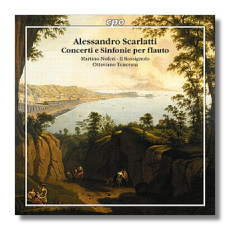
The Internet's Premier Classical Music Source
Related Links
- A. Scarlatti Reviews
- Latest Reviews
- More Reviews
-
By Composer
-
Collections
DVD & Blu-ray
Books
Concert Reviews
Articles/Interviews
Software
Audio
Search Amazon
Recommended Links
Site News
 CD Review
CD Review
Alessandro Scarlatti

Concertos & Sinfonias
- Concerto in D Major for Recorder, 2 Violins & Continuo
- Concerto in F Major for 3 Recorders & Continuo
- Concerto in A Major for Recorder, 2 Violins & Continuo
- Concerto in F Major for Recorder, 2 Violins & Continuo
- Concerto in A Major for 2 Recorders, 2 Violins & Continuo
- Sinfonia in G Major for Recorder & Continuo
- Sinfonia in F Major for Recorder & Continuo
- Sonata in G minor for 2 Recorders & Continuo
Martino Noferi, recorder
Il Rossignolo/Ottoviano Tenerani
CPO 999856-2 DDD 53:24
Although Alessandro Scarlatti's popularity today lags behind that of his son Domenico, he was an acclaimed and well-known composer at the time of his death in 1725. Every now and then, a new recording comes along to remind us of why he deserved his accolades. The present one focuses on concertante music for recorder – the booklet note uses the words "flute" and "recorder" interchangeably – with or without additional recorders or solo violins.
The preponderance of major keys suggests that the music on this CD will be cheerful, and cheerful it is, even brilliant. Scarlatti keeps things moving, too; concertos as brief as seven minutes in length can have as many as five movements. This is a good place to explain the difference between a concerto and a sinfonia, as Scarlatti understood it. Actually, there wasn't much difference as all, as Scarlatti used the term "sinfonia" in its most basic sense, that is, music consisting parts that harmonize (or "sound") together. It is hard for me, however, to figure out what this really means, as the two fugal movements on this disc belong to concertos, and the works that feature more than one soloist are the concertos and the sonata. Never mind. These works are consistently engaging – light music at its least condescending, and often quite "vocal" in their songfulness. Scarlatti demands agility from his soloists, so it is clear that these works were not composed for amateurs.
Noferi and the members of Il Rossignolo play period instruments. The sound is very light, and Tenerani, who leads from the harpsichord, has pared the ensemble's size down to a minimum for these works. The biggest challenge to listeners may be the recorders themselves. There is a lot of "bent pitch" – momentary flatting or sharping of the main pitch – in these performances. Each note is seldom a "bull's eye" – the soloists swim around the note expressively. It's almost like what one hears from jazz vocalists. Listeners who are not used to period instruments will be driven crazy by this. I found it charming, but sometimes it was too much of a good thing.
The recording was made in Sovigliana, Italy, in the spring of 2001. The engineers have given the musicians a brilliant "hot" sound which allows us to hear almost every breath from Noferi and his colleages. Again, I found this charming at first, but it eventually became too much of a good thing as well.
Copyright © 2002, Raymond Tuttle



















